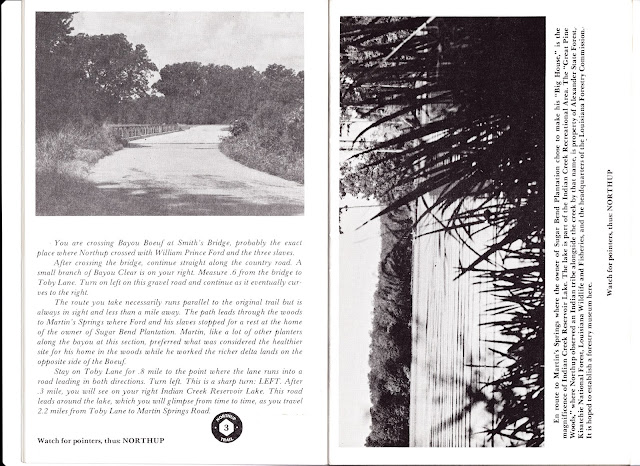(pg. 7) You are crossing Bayou Beouf at Smith's Bridge, probably the exact place where Northup crossed with William Prince Ford and the three slaves.
 |
| Smith's Landing Historical Marker (courtesy of historyhunts) |
 |
| The Old Depot (courtesy of historyhunts) |
After crossing the bridge, continue straight along the country road. A small branch of Bayou Clear is on your right. Measure 0.6 from the bridge to Toby Lane. Turn on left on this gravel road and continue as it eventually curves to the right.
The route you take necessarily runs parallel to the original trail but is always in sight and less than a mile away. The path leads through the woods to Martin's Springs where Ford and his slaves stopped for a rest at the home of the owner of Sugar Bend Plantation. Martin, like a lot of other planters along the bayou at this section, preferred what was considered the healthier site for his home in the woods while he worked the richer delta lands on the opposite side of the Boeuf.
Stay on Toby Lane for 0.8 mile to the point where the lane runs into a road leading in both directions. Turn left. This is a sharp turn: LEFT. After 0.3 mile, you will see on your right Indian Creek Reservoir Lake. This road leads around the lake, which you will glimpse from time to time, as you travel 2.2 miles from Toby Lane to Martin Springs Road.
(pg. 8) En route to Martin's Springs where the owner of Sugar Bend Plantation chose to make his "Big House," is the magnificence of Indian Creek Reservoir Lake. The lake is part of the Indian Creek Recreational Area. The "Great Pine Woods," where Northup observed an Idian tribe alongside the creek by that name, is property of Alexander State Forest, Kisatchie National Forest, Louisiana Wildlife and Fisheries, and the headquarters of the Louisiana Forestry Commission. It is hoped to establish a forestry museum here.
In regard to the Native Americans that Northup noted, I discovered that US Gen Web Archives contains information regarding those Native Americans:
"The Choctaw settled in a strip running from the Red River in the area of the
Appalaches Village (Zimmerman), south-southeast to Pine Prairie. The Yowani
Choctaw were well established in central Louisiana as early as the mid-1750's,
coming from the permanent village on Bayou Chicot into the vicinity of Clifton.
There were Choctaw settlements at Boyce, Flatwoods, Clifton Crossing, Hineston,
Seiper Creek, and Woodworth."

No comments:
Post a Comment